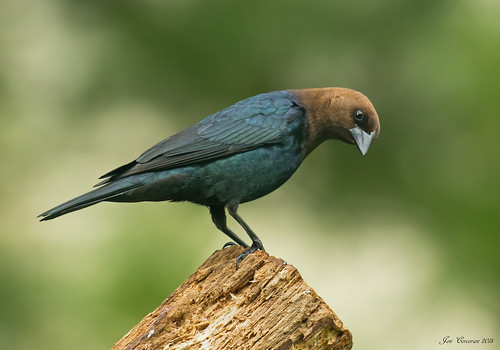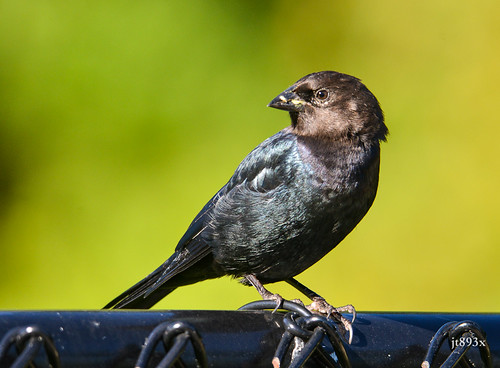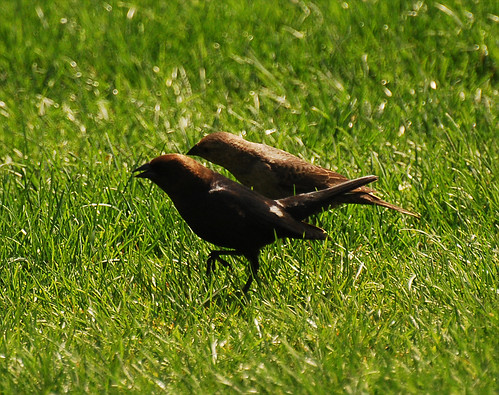Brown-headed Cowbird
(Molothrus ater)
Conservation • Description • Habitat • Ecology • Distribution • Taxonomy
Conservation Status |
|
|||||||
| IUCN Red List | LC - Least Concern |
|||||||
| NatureServe | N5B - Secure SNRB - Unranked Breeding |
|||||||
| Minnesota | not listed |
|||||||
Description |
||
|
||
Size |
||
7½″ to 8¾″ in length |
||
Voice |
||
Similar Species |
||
Habitat |
||
Woodland edges, fields, prairies, meadows. |
||
Ecology |
||
Migration |
||
|
||
Nesting |
||
|
||
Food |
||
|
||
Distribution |
||||
Occurrence |
||||
Common to abundant |
||||
Maps |
||||
The Minnesota Ornithologists’ Union All Seasons Species Occurrence Map |
||||
Taxonomy |
|||
| Class | Aves (birds) | ||
Order |
Passeriformes (perching birds) | ||
Family |
Icteridae (New World blackbirds and orioles) | ||
Genus |
Molothrus (cowbirds) | ||
Subordinate Taxa |
|||
Sagebrush Cowbird (Molothrus ater artemisiae) Eastern Cowbird (Molothrus ater ater) California Cowbird (Molothrus ater californicus) Dwarf Cowbird (Molothrus ater obscurus) |
|||
|
|||
Synonyms |
|||
|
|||
Visitor Photos |
|||||
Share your photo of this bird. |
|||||
| This button not working for you? Simply email us at info@MinnesotaSeasons.com. Attach one or more photos and, if you like, a caption. |
|||||
Kirk Nelson |
|||||
Under the bird feeders near the Visitors’ Center |
|||||
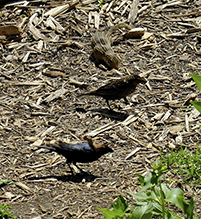 |
|||||
Ramona Abrego |
|||||
Spring mating ritual |
|||||
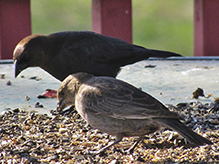 |
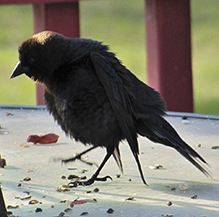 |
||||
Lynn Rubey |
|||||
A female Brown-headed Cowbird in a young sapling in The Big Stone Nation Wildlife Refuge. |
|||||
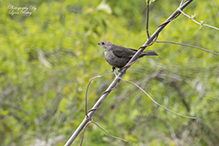 |
|||||
MinnesotaSeasons.com Photos |
|||||
Male |
|||||
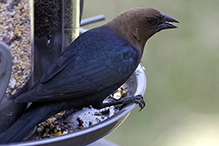 |
|||||
Female |
|||||
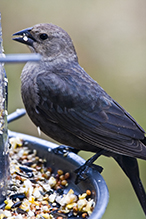 |
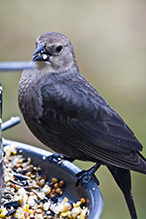 |
||||
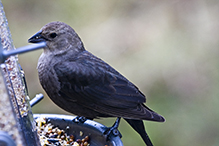 |
|||||


Visitor Videos |
|||
Share your video of this bird. |
|||
| This button not working for you? Simply email us at info@MinnesotaSeasons.com. Attach a video, a YouTube link, or a cloud storage link. |
|||
Other Videos |
|||
| Brown-headed Cowbirds (Icteridae: Molothrus ater) Juveniles Carl Barrentine |
|||
About
Published on Aug 6, 2012 Photographed at the Turtle River State Park, North Dakota (06 August 2012). |
|||
| Brown-headed Cow Bird videofilmik |
|||
About
Uploaded on May 1, 2011 The Brown-headed Cowbird (Molothrus ater) is a small brood parasitic icterid of temperate to subtropical North America. They are permanent residents in the southern parts of their range; northern birds migrate to the southern United States and Mexico in winter, returning to their summer habitat about March/April.[1] They resemble New World orioles in general shape but have a finch-like head and beak. Adults have a short finch-like bill and dark eyes. The adult male is mainly iridescent black with a brown head. The adult female is grey with a pale throat and fine streaking on the underparts. (wikipedia) |
|||
| Brown-headed Cowbird (Icteridae: Molothrus ater) Female Carl Barrentine |
|||
About
Uploaded on Jun 25, 2009 Photographed near the Kellys Slough NWR, North Dakota (25 June 2009). |
|||
| Brown-headed Cowbird (Icteridae: Molothrus ater) Male Carl Barrentine |
|||
About
Uploaded on Jun 24, 2009 Photographed near Kellys Slough NWR, North Dakota (24 June 2009). |
|||

Visitor Sightings |
|||||
Report a sighting of this bird. |
|||||
| This button not working for you? Simply email us at info@MinnesotaSeasons.com. Be sure to include a location. |
|||||
| Nicola and Tom 9/9/2022 |
Location: Hampshire, UK I live in Hampshire, UK. Over the last week we have noticed 3 Brownheaded Cowbirds in our back garden. We notice that one stays around for most of the day but the other 2 disappear quite quickly. The local blackbirds have been trying to shoo it away but he/she is standing their ground. Can you tell us if they travel this far. There are reported sightings further north around 8 sightings in individual areas but we are near the coast but also inland in the south. If that makes sense. Would be grateful for feedback. Apologies if we have contacted you in error but found your website useful. |
||||
| John Valo 9/9/2022 |
You already know as much as I have been able to find out. If you have sightings in Sheffield, it is only a matter of time before there are sightings further south. Sorry I couldn’t be of more help. I can’t help but think of the introduction of the European Starling into New York Central Park in 1890. Today the species is common across the continent. The birds eat berries and agricultural crops, and aggressively drive away native bird species. It is considered invasive. Brown-headed Cowbird is a brood parasite. I expect it will become as unwelcome in your country as the European Starling is in ours. |
||||
| Kirk Nelson 6/7/2020 |
Location: Minnesota Valley National Wildlife Refuge, Long Meadow Lake Unit Under the bird feeders near the Visitors’ Center |
 |
|||
| M. Dunne 6/23/2020 |
Location: Central Bloomington near 86th & Penn Ave So Had never seen this bird before. It was unmistakably a male B-H Cowbird in our yard eating seed from a feeder |
||||
| Ramona Abrego | Location: Washington County Spring mating ritual |
 |
|||
| Lynn Rubey 5/23/2019 |
Location: Big Stone National Wildlife Refuge A female Brown-headed Cowbird in a young sapling in The Big Stone Nation Wildlife Refuge. |
 |
|||
| LoriMinnesota 4/27/2017 |
Location: Arlington, Minnesota (Sibley County) I have never seen this bird before and had to come to this site to figure out what it was. Today, I have a half a dozen of them pecking at seeds on the ground that fell under my bird feeder. |
||||
MinnesotaSeasons.com Sightings |
|||||
Avon Hills Forest SNA, North Unit Big Stone National Wildlife Refuge Cannon River Turtle Preserve SNA Clinton Falls Dwarf Trout Lily SNA Forestville/Mystery Cave State Park Mary Schmidt Crawford Woods SNA Minnesota Valley NWR, Black Dog Unit Minnesota Valley State Recreation Area, Lawrence Unit Nerstrand Big Woods State Park Sand Prairie Wildlife Management and Environmental Education Area Sherburne National Wildlife Refuge |
|||||

|
Created: Last Updated: © MinnesotaSeasons.com. All rights reserved. |
